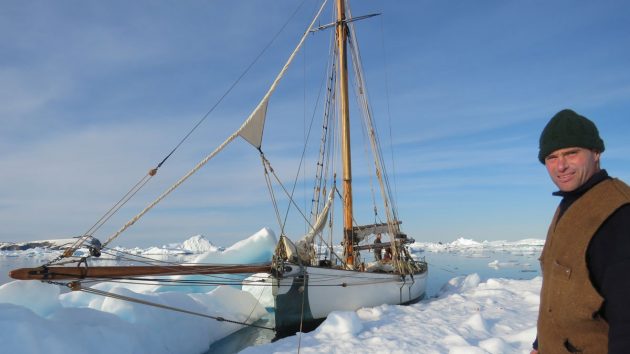A Plymouth shipwright is attempting to sail through the notorious ice-bound Northwest Passage in a 43ft wooden ‘gentlemen’s cutter’ that he designed himself.
Will Stirling and three crew set sail on 1 June aboard Integrity, a new boat built to an 1880s Victorian cutter design by his team at Stirling & Son.
Their 6,000-mile east-west transit of the Passage began in south-east Canada and will pass through western Greenland, northern Canada to Alaska, where they hope to finish in mid-September.
To put the Northwest Passage into perspective, Atlantic Rally for Cruisers founder and cruising author Jimmy Cornell had a Garcia Exploration 45 aluminium yacht built specially to sail the route; it took him two attempts and he endured some “terrifying” ice encounters.

Roald Amundsen was the first to sail through during his 1903-1906 Northwest Passage expedition, and there have been numerous attempts – and failures – in various types of boats since then.
The first woman to sail single-handed through the Passage was German skipper Susanne Huber-Curphey in 2017 aboard a 39ft Koopmans cutter with a full keel, oversized hull and rigging.
Although Will Stirling favours traditional navigation, using dead reckoning on the way to Newfoundland, and keeping a full set of paper charts on board, he also has a charting app on his iPhone.
From Greenland onwards, the crew will be using a satellite phone to download ice charts from the Canadian coastguard. There is a 50/50 risk of getting trapped if ice conditions are heavy or deteriorate.

Fog, ice and bad weather are the main concerns and the real danger is being struck by ice floes, weighing in at one tonne per cubic metre, driven by wind and tides. Another risk is encounters with polar bears.
Will intends to change crew twice mid-passage during the voyage, in Greenland and Resolute. Crewmembers include high-latitude sailors, ex-marines, boatbuilders and fishermen.
Will’s wife Sara said: “The crew are people who you can rely on – mostly people we know and have sailed with before, who are calm, competent and can pull together to deal with stuff. There will always be challenges to deal with. When you’re on a long trip you also need people who won’t irritate each other in close quarters.”

Sara, who provisioned ‘four months of four-person meals’ for the voyage, will join the crew in Greenland. Hundreds of teabags, packets of oats for porridge and making flapjacks, nuts, biscuits, cartons of UHT milk, yeast and flour for breadmaking were among the goods stowed away – in lockers, in drybags down below, and taking up half of Will’s bunk in his double cabin.
Continues below…
French skipper and pet hen complete gruelling Northwest Passage
After 32 days, 3400 miles (6000 km) struggling against the cold, hunger, and fatigue, French skipper Guirec Soudée and his…
Jimmy Cornell: “How I’ve coped with almost every type of emergency at sea”
Perhaps it is inevitable in my long and eventful sailing life that I’ve faced a number of emergency situations. In…
Trapped in thick fog with my 8-year-old daughter whilst on passage to France
Navigating through fog is frightening. At 91 years of age my sailing career is over, but I can’t grumble as…
Will’s past sailing adventures include restoring a 1938 19ft sailing project boat he bought for £200, and sailing to Norway, then later to Cornwall via the Shetland Islands.
In 2007, Will sailed Alert, the first boat he built from scratch, to Iceland – his Arctic debut. He has returned all but one summer since.

Sara added: “They’ve had to stop twice so far because of bad weather. When it’s good weather they go for it, when it’s bad they tuck into a little harbour or cove and wait it out.
“Will’s not doing this to break any records, although it will be an achievement and a challenge.”
You can follow Will Stirling’s progress aboard Integrity via the Stirling and Son Facebook page.
In their latest post, Will said: “300 miles sailed along Nova Scotia, through the Bras D’Or lakes and across Cabot Straight to Newfoundland.
“Inevitably – it’s a boat – a list of snags have risen to the surface so we have made the planned stop in Codroy, Newfoundland to iron those out and plan to sail North again tomorrow.
“Last year we weathered the once in a blue moon hurricane in Codroy’s sheltered little harbour near the Wreckhouse Mountains. Due to the strength of wind at that time the boat was secured to the quay by her mast and rudder stock.
“Whilst conditions are much more clement this time, the warmth and generosity of the locals remains the same.
“So far conditions at sea have been plenty of fog, rain and cold and windy weather; probably not conditions we should be grumbling about yet.”







